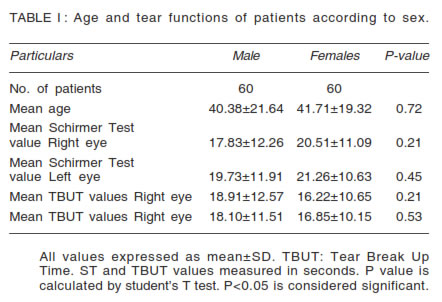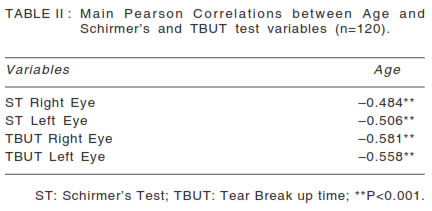and Pharmacology
Indian Journal of Physiology and Pharmacology |
 (252x320).jpg) |
Volume 58 - Number 2 April - 2014 (Current issue) ISSN 0019-5499 |
Assessment of Tear Secretions in Healthy Indian VolunteersPanna Mishra, Divya Srivastava, Rajesh Misra, V K Malik
and Vikas Trivedi |
Dry eye syndrome is currently seen with increasing frequency throughout the world including India. An evaluation of tear physiology in the form of tear secretion and tear film stability is the most important aspect of dry eye diagnosis. The aim of this study is to investigate the age and gender related changes in the result of these tear function tests (Schirmers Test and Tear Break up time) in normal Indian population. This crosssectional observational study included 120 normal subjects (60 Male and 60 females) with no ocular symptoms or ocular surface disorders. Schirmer and tear film break-up time tests were assessed in both eyes of each subject. The study subjects were divided into 4 groups according to their ages (< 20y, 20-40y, 41-60y and > 60y) each group was composed of 60 eyes of 30 subjects (15 male and 15 female subjects). The One way ANOVA test and the Statagraphic software was used for statistical analysis. We detected a statistically significant decline in both the tear function tests with increasing age. Tear function tests did not show statistically significant difference according to sex. This study suggests that the age of subjects should be taken into consideration in the evaluation of tear function test results. It is also revealed that Indian population values are different from Caucasian and Chinese values. We propose age specific cut off values of tear function tests in Indian population to aid in the diagnosis of dry eye in Indian conditions. |
Tears are important in maintaining the clarity of
cornea, in providing a clear vision, in the defense
mechanism of the eye, and in producing soothing
effect to the eyes. In today's scenario, due to various
factors like increasing life span of people,
environmental pollution, excessive use of TV, computers and air conditioning systems there are
increasing incidence of abnormalities of tear
physiology. An estimate of tear secretion and tear
film stability is regarded as the most important
aspects in study of tear physiology, and for this
purpose, the Schirmer's test and the tear film breakup
time (BUT) tests are currently in use (1, 2). A
measurement
of < 10 mm of wetting is commonly
accepted as abnormal for the Schirmer's test when
it is performed without topical anaesthesia and a
value of < 10 s is considered as abnormal for the
tear film BUT test (3, 4). Because of these data, we
thought that tear functions may change with the
advancing age and gender. We have not come across
any study on general Indian population about age
and gender-related changes of tear function in current literature. In this study, we aim to investigate the
age and gender-related changes in the results of
Schirmer's and tear film BUT tests in adult healthy
Indian volunteers. Through this study we also aim to
propose age-specific Schirmer's test values and tear
film BUT cut off values in normal Indian population in
the diagnosis of tear physiology abnormalities or dry
eye. |
This study was conducted by Departments of Physiology and Ophthalmology at Subharti Medical College, Meerut, between October 2011 and March 2012. The Institutional Medical Ethics Committee approval for the study was obtained, and all patients included in the study gave written informed consent. The study protocol followed the guidelines of the Declaration of Helsinki. Participants included staff and students of the Subharti Medical College, Meerut. A total of 120 participants between 5 to 60 years were divided into 4 groups, < 20 years, 20-40 years, 41-60 years and > 60 years. There were 30 subjects in each group, 15 males and 15 females. Any history of ocular surgery or ocular trauma, any ocular surface disorder, current contact lens use, any topical or systemic drug use, any systemic disorder, such as Diabetes and Hypertension were regarded as exclusion criteria. Ocular examination All subjects underwent a complete ophthalmic examination. The Schirmer's and the tear film BUT tests were performed in both eyes of each subject. Tear film BUT was undertaken without the use of any anesthetics after instilling one drop of fluorescein (2% strip Alcon-Co) into the lower fornix and subjects were instructed to blink several times for a few seconds. The tear film was observed using a blue cobalt filter under wide lighting. The interval after the last blinking to the appearance of first black spot was detected. The test was repeated three times, and the median score was recorded in seconds. After resting period for 20 min, the modified Schirmer's basal and reflex tear secretion test was performed in both eyes of the subject. A Standard Whatman number 41 filter paper strip, 5 mm wide and 35 mm long (Whatmann, Maidstone, UK), was folded 5 mm from one end and placed between the lower eyelid and the globe, taking care not to touch the cornea, at the junction between the middle and lateral third of the eyelid. The patient was allowed to blink normally. Wetting was measured at 5 min in millimeters. This measured both the reflex and basal tear production. Statistical analysis The P value P<0.05 was deemed as statistically significant. The two groups were compared using student's 't' test. Statagraphic software was used for doing statistical analysis. |
Mean age of the study subjects, mean values of
Schirmer's test in both eyes, mean values of TBUT
both eyes, according to sex with derivation of P
values are presented in Table I. There was no
significant difference in age and various parameters
in males and females. Significant relation was found
between age and Schirmer's test value and also
between age and TBUT values. They are negatively
correlated i.e. the value of Schirmer's test value as
well as TBUT values decreases with advancing age
in all population groups (Table II). Our results show
significant decrease in both TBUT and Schirmer's
test values with increasing age in both genders and
also a positively correlated decline in both TBUT
and Schirmer's values. Based on the above results
we are proposing age specific cut off values for the tear function tests. (Table III). These cut-off values
are specific for Indian population and suggest a way
ahead for evaluation of tear function tests. We did
not find any significant gender related difference in
these values. |
 |
 |
 |
The population-based studies revealed that dry eye syndrome, an important health problem, is seen throughout the world with a frequency of up to 33% (5). There has been very few studies in the literature, which have assessed the changes in tear secretion in the Indian population, in the recent times. Therefore, we aim to investigate the age and gender-related changes in the results of Schirmer's and tear film BUT tests in adult healthy Indian volunteers. The basal Schirmer's test quantitatively evaluates the basic tear production. The tear film BUT test reflects tear stability and composition. In this study, we found that the tear film BUT and ST values decreased significantly with aging. Agerelated reduction of the tear film BUT test values was parallel in both genders. Earlier studies detected that disorder of the lid margin morphology and decreased Meibomian gland secretion are very common findings among the elderly patients. These problems lead to the increase of surface tension and early evaporation of tear film (6-8). According to some studies, decreased serum androgen level may cause a disorder of Meibomian gland functions and evaporative dry eye (9). The demonstration of androgen treatment to increase tear production in mice with Sjogren syndrome also substantiates this idea (10). However, it is known that in women reduced sex hormone levels after menopause cause dryness in all mucosal tissues as well as affecting the tear production negatively (11). TBUT values and ethnicity The normal values of tear film BUT as reported by western workers ranged from 25 to 30 seconds (12, 13) and they believe that any value of tear film BUT under 15 seconds is pathological. In our study, the mean TBUT in male was 18.91+12.57s whereas in female it was 16.22+10.65s and the total mean was 17.52s which is lower than earlier studies done in western countries. We believe that the low tear film BUT compared to western countries is due to tropical climatic conditions as against the temperate climate of western countries, which would account for a higher break up time in western subjects. However, tear film BUT in India by Maudgil et al (14) in normal subjects was lower than 15 seconds. This difference could be explained by the large variation in the inter subject values often reported in other studies (15). Also, in this study we have taken equal number of subjects in different age groups which was not so in the previous study. The difference can also be accounted to a gap of nearly 20 years in both the studies. Because of the differing reports in the literature on TBUT studies, the cutoff value of 10 seconds which was made earlier should be revised for various ethnic groups. A cutoff point of 5 seconds has been suggested for the Chinese group (13). Another recommendation from our study may be to suggest a lower cut off value for our population which could be 9 seconds. The important caveats of our study are small sample size, bigger age groups, limited study period and single center location. Conclusion To conclude, our study showed that normal values of tear function tests and tear physiology change with the advancing age, especially tear film BUT decreases markedly. Besides, the changes in tear physiology are parallel in both sexes and shows no marked difference. Through this study we also proposed age-specific Schirmer's test values and tear BUT cut off values in normal Indian population in the diagnosis of tear physiology abnormalities or dry eye. |
|